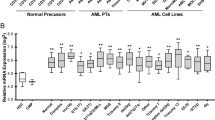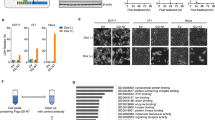Abstract
Human T-cell leukemia is a malignant disease that needs various regimens of cytotoxic chemotherapy to overcome drug resistance. Recently, Na+,K+-ATPase has emerged as a potential target for cancer therapy. However, its exact signaling pathway in human T-cell leukemia cell death has not been well defined. In the current study, we found CD95(APO-1) was able to trigger the internalization of plasma membrane Na+,K+-ATPase in Jurkat cells or primary T cells as a mechanism to suppress its activity. This internalization was closely relevant to intracellular glutathione (GSH) depletion in Jurkat cells downstream of Fas-associated death domain protein (FADD) and caspase 8. GSH depletion in Fas L-treated Jurkat cells induced the generation of hydrogen peroxide (H2O2), which subsequently increased the serine phosphorylation of Na+,K+-ATPase α1 subunit. Exogenous H2O2 even mimicked the effect of Fas L to upregulate the serine phosphorylation of Na+,K+-ATPase α1 subunit and suppress Na+,K+-ATPase activity. Overall, our results indicate that CD95(APO-1) induces the FADD- and caspase 8-dependent internalization of Na+,K+-ATPase through intracellular GSH loss, and the subsequent generation of H2O2-mediated serine phosphorylation of Na+,K+-ATPase α1 subunit. Taken together, this study presents a novel regulatory mechanism of Na+,K+-ATPase in CD95(APO-1)-mediated human T-leukemia cell apoptosis.
This is a preview of subscription content, access via your institution
Access options
Subscribe to this journal
Receive 12 print issues and online access
$259.00 per year
only $21.58 per issue
Buy this article
- Purchase on Springer Link
- Instant access to full article PDF
Prices may be subject to local taxes which are calculated during checkout







Similar content being viewed by others
References
Uchiyama T, Yodoi J, Sagawa K, Takatsuki K, Uchino H . Adult T-cell leukemia: clinical and hematologic features of 16 cases. Blood 1977; 50: 481–492.
Yasunaga J, Sakai T, Nosaka K, Etoh K, Tamiya S, Koga S et al. Impaired production of naive T lymphocytes in human T-cell leukemia virus type I-infected individuals: its implications in the immunodeficient state. Blood 2001; 97: 3177–3183.
Gupta RS, Chopra A, Stetsko DK . Cellular basis for the species differences in sensitivity to cardiac glycosides (digitalis). J Cell Physiol 1986; 127: 197–206.
Frese S, Frese-Schaper M, Andres AC, Miescher D, Zumkehr B, Schmid RA . Cardiac glycosides initiate Apo2L/TRAIL-induced apoptosis in non-small cell lung cancer cells by up-regulation of death receptors 4 and 5. Cancer Res 2006; 66: 5867–5874.
Sreenivasan Y, Raghavendra PB, Manna SK . Oleandrin-mediated expression of Fas potentiates apoptosis in tumor cells. J Clin Immunol 2006; 26: 308–322.
Bortner CD, Gomez-Angelats M, Cidlowski JA . Plasma membrane depolarization without repolarization is an early molecular event in anti-Fas-induced apoptosis. J Biol Chem 2001; 276: 4304–4314.
Krammer PH . CD95's deadly mission in the immune system. Nature 2000; 407: 789–795.
Nelson BH, Willerford DM . Biology of the interleukin-2 receptor. Adv Immunol 1998; 70: 1–81.
Ross DD . Novel mechanisms of drug resistance in leukemia. Leukemia 2000; 14: 467–473.
Hill ME, MacLennan KA, Cunningham DC, Vaughan Hudson B, Burke M, Clarke P et al. Prognostic significance of BCL-2 expression and bcl-2 major breakpoint region rearrangement in diffuse large cell non-Hodgkin's lymphoma: a British National Lymphoma Investigation Study. Blood 1996; 88: 1046–1051.
Doris PA, Jenkins LA, Stocco DM . Is ouabain an authentic endogenous mammalian substance derived from the adrenal? Hypertension 1994; 23: 632–638.
Harper N, Hughes M, MacFarlane M, Cohen GM . Fas-associated death domain protein and caspase-8 are not recruited to the tumor necrosis factor receptor 1 signaling complex during tumor necrosis factor-induced apoptosis. J Biol Chem 2003; 278: 25534–25541.
Shu L, Yin W, Zhuang H, Hua Z . Comparison of gene expression profiles in mouse primary T cells under normal and prolonged activation. Blood Cells Mol Dis 2006; 37: 64–75.
Nobel CS, Aronson JK, van den Dobbelsteen DJ, Slater AF . Inhibition of Na+,K+-ATPase may be one mechanism contributing to potassium efflux and cell shrinkage in CD95-induced apoptosis. Apoptosis 2000; 5: 153–163.
Deng X, Yin F, Lu X, Cai B, Yin W . The apoptotic effect of brucine from the seed of Strychnos nux-vomica on human hepatoma cells is mediated via Bcl-2 and Ca2+ involved mitochondrial pathway. Toxicol Sci 2006; 91: 59–69.
Yin W, Jiang G, Takeyasu K, Zhou X . Stimulation of Na+,K+-ATPase by low potassium is dependent on transferrin. J Membr Biol 2003; 193: 177–184.
Wang XQ, Xiao AY, Sheline C, Hyrc K, Yang A, Goldberg MP et al. Apoptotic insults impair Na+, K+-ATPase activity as a mechanism of neuronal death mediated by concurrent ATP deficiency and oxidant stress. J Cell Sci 2003; 116: 2099–2110.
Ju ST, Panka DJ, Cui H, Ettinger R, el-Khatib M, Sherr DH et al. Fas(CD95)/FasL interactions required for programmed cell death after T-cell activation. Nature 1995; 373: 444–448.
Tsai-Turton M, Luderer U . Opposing effects of glutathione depletion and follicle-stimulating hormone on reactive oxygen species and apoptosis in cultured preovulatory rat follicles. Endocrinology 2006; 147: 1224–1236.
Muyderman H, Nilsson M, Sims NR . Highly selective and prolonged depletion of mitochondrial glutathione in astrocytes markedly increases sensitivity to peroxynitrite. J Neurosci 2004; 24: 8019–8028.
Armstrong JS, Steinauer KK, Hornung B, Irish JM, Lecane P, Birrell GW et al. Role of glutathione depletion and reactive oxygen species generation in apoptotic signaling in a human B lymphoma cell line. Cell Death Differ 2002; 9: 252–263.
Ridge KM, Dada L, Lecuona E, Bertorello AM, Katz AI, Mochly-Rosen D et al. Dopamine-induced exocytosis of Na+,K+-ATPase is dependent on activation of protein kinase C-epsilon and -delta. Mol Biol Cell 2002; 13: 1381–1389.
Dada LA, Chandel NS, Ridge KM, Pedemonte C, Bertorello AM, Sznajder JI . Hypoxia-induced endocytosis of Na+,K+-ATPase in alveolar epithelial cells is mediated by mitochondrial reactive oxygen species and PKC-zeta. J Clin Invest 2003; 111: 1057–1064.
Lingrel JB, Kuntzweiler T . Na+,K+-ATPase. J Biol Chem 1994; 269: 19659–19662.
Franco R, Bortner CD, Cidlowski JA . Potential roles of electrogenic ion transport and plasma membrane depolarization in apoptosis. J Membr Biol 2006; 209: 43–58.
Zhou X, Yin W, Doi SQ, Robinson SW, Takeyasu K, Fan X . Stimulation of Na+,K+-ATPase by low potassium requires reactive oxygen species. Am J Physiol Cell Physiol 2003; 285: C319–C326.
Pedemont CH, Bertorello AM . Short-term regulation of the proximal tubule Na+,K+-ATPase: increased/decreased Na+,K+-ATPase activity mediated by protein kinase C isoforms. J Bioenerg Biomembr 2001; 33: 439–447.
Hammond CL, Lee TK, Ballatori N . Novel roles for glutathione in gene expression, cell death, and membrane transport of organic solutes. J Hepatol 2001; 34: 946–954.
Devadas S, Zaritskaya L, Rhee SG, Oberley L, Williams MS . Discrete generation of superoxide and hydrogen peroxide by T cell receptor stimulation: selective regulation of mitogen-activated protein kinase activation and Fas ligand expression. J Exp Med 2002; 195: 59–70.
Elmoselhi AB, Butcher A, Samson SE, Grover AK . Free radicals uncouple the sodium pump in pig coronary artery. Am J Physiol 1994; 266: C720–C728.
Shao Q, Matsubara T, Bhatt SK, Dhalla NS . Inhibition of cardiac sarcolemma Na+,K+-ATPase by oxyradical generating systems. Mol Cell Biochem 1995; 147: 139–144.
Gilbert M, Knox S . Influence of Bcl-2 overexpression on Na+,K+-ATPase pump activity: correlation with radiation-induced programmed cell death. J Cell Physiol 1997; 171: 299–304.
Ushio-Fukai M, Alexander RW, Akers M, Griendling KK . p38 Mitogen-activated protein kinase is a critical component of the redox-sensitive signaling pathways activated by angiotensin II. Role in vascular smooth muscle cell hypertrophy. J Biol Chem 1998; 273: 15022–15029.
Sordet O, Rebe C, Leroy I, Bruey JM, Garrido C, Miguet C et al. Mitochondria-targeting drugs arsenic trioxide and lonidamine bypass the resistance of TPA-differentiated leukemic cells to apoptosis. Blood 2001; 97: 3931–3940.
Fernandez C, Ramos AM, Sancho P, Amran D, de Blas E, Aller P . 12-O-tetradecanoylphorbol-13-acetate may both potentiate and decrease the generation of apoptosis by the antileukemic agent arsenic trioxide in human promonocytic cells. Regulation by extracellular signal-regulated protein kinases and glutathione. J Biol Chem 2004; 279: 3877–3884.
Efendiev R, Bertorello AM, Pedemonte CH . PKC-beta and PKC-zeta mediate opposing effects on proximal tubule Na+,K+-ATPase activity. FEBS Lett 1999; 456: 45–48.
Acknowledgements
We thank Professor Cohen and Dr Harper from UK for the generous gifts of FADD-, caspase 8-deficient Jurkat cell, and Dr Bortner CD from USA for providing protocol and comments in measuring plasma membrane depolarization. This project was supported by Natural Science Fund of China to Dr Zi-Chun Hua (30425009, 30330530) and to Dr Yin Wu (30470644, 30600502), and the Ministry of Education of China (TRAPOY 199028418, SRFDP 20030284040).
Author information
Authors and Affiliations
Corresponding author
Additional information
Supplementary Information accompanies the paper on the Leukemia website (http://www.nature.com/leu)
Supplementary information
Rights and permissions
About this article
Cite this article
Yin, W., Cheng, W., Shen, W. et al. Impairment of Na+,K+-ATPase in CD95(APO-1)-induced human T-cell leukemia cell apoptosis mediated by glutathione depletion and generation of hydrogen peroxide. Leukemia 21, 1669–1678 (2007). https://doi.org/10.1038/sj.leu.2404791
Received:
Revised:
Accepted:
Published:
Issue Date:
DOI: https://doi.org/10.1038/sj.leu.2404791
Keywords
This article is cited by
-
The influence of oxo-bridged binuclear gold(III) complexes on Na/K-ATPase activity: a joint experimental and theoretical approach
JBIC Journal of Biological Inorganic Chemistry (2017)
-
Mitochondrial inhibitor sensitizes non-small-cell lung carcinoma cells to TRAIL-induced apoptosis by reactive oxygen species and Bcl-XL/p53-mediated amplification mechanisms
Cell Death & Disease (2014)
-
Involvement of Na+, K+-ATPase and its inhibitors in HuR-mediated cytokine mRNA stabilization in lung epithelial cells
Cellular and Molecular Life Sciences (2011)
-
A Role for Potassium Permeability in the Recognition, Clearance, and Anti-inflammatory Effects of Apoptotic Cells
Molecular Neurobiology (2010)
-
Ouabain-induced perturbations in intracellular ionic homeostasis regulate death receptor-mediated apoptosis
Apoptosis (2010)



